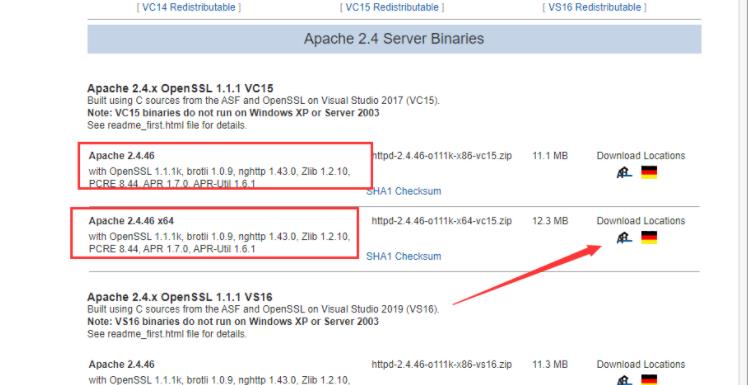 Operation and Maintenance
Operation and Maintenance Apache
Apache Apache Interview Questions: Ace Your System Administrator Interview
Apache Interview Questions: Ace Your System Administrator InterviewWhen preparing for an Apache system administrator interview, you should master the following core knowledge points: 1. Apache's virtual hosting function allows a single server to host multiple domain names or websites. 2. Apache's module system extends functions through loading modules, such as logging and security authentication. 3. Apache's configuration file (such as httpd.conf) defines server settings and virtual host configuration. 4. Basic operations include starting, stopping and restarting the Apache server. 5. Advanced configurations such as SSL/TLS certificate settings to implement HTTPS connections. 6. Common errors are debugged by checking the configuration file syntax and viewing the error log. 7. Performance optimization methods include enabling caching and selecting multithreaded or multiprocess modes. 8. Best practices emphasize the readability and maintainability of configuration files.
introduction
You may feel both excited and nervous when preparing for an Apache system administrator interview. Apache HTTP Server is one of the most popular web servers in the world, so getting to know it in depth will not only improve your technical capabilities, but also stand out in the interview. This article will take you into the deep understanding of the problems you may encounter in Apache interviews, helping you prepare better and boost your confidence. I will share some FAQs and answers, and combine my own experience to provide some unique insights and suggestions, hoping to help you pass the interview smoothly.
Review of basic knowledge
Apache HTTP Server, or Apache for short, is an open source web server software that was originally developed by Robert McCool in 1995. It is maintained by the Apache Software Foundation and supports a variety of operating systems, including Unix, Linux, Windows, etc. Known for its stability, reliability and flexibility, Apache supports multiple module expansions to meet a variety of needs.
When preparing for the Apache interview, it is very important to understand some basic concepts, such as virtual hosting, modules, configuration files, etc. These concepts are not only common topics in interviews, but also the basis for understanding how Apache works.
Core concept or function analysis
Apache's virtual host
Virtual hosting is a powerful feature of Apache that allows a single server to host multiple domain names or websites. By configuring a virtual host, you can map different domain names to different directories, so that multiple websites share a single server.
<VirtualHost *:80>
ServerName www.example.com
DocumentRoot /var/www/example
</VirtualHost>
<VirtualHost *:80>
ServerName www.anothersite.com
DocumentRoot /var/www/anothersite
</VirtualHost> This configuration example shows how to set up a virtual host for two different domain names. Each <virtualhost></virtualhost> block defines a virtual host, ServerName specifies the domain name, and DocumentRoot specifies the root directory of the website.
Apache's module system
Apache's module system is key to its flexibility. Modules can extend Apache's functions, from basic logging to complex security authentication, Apache has corresponding modules to support. You can enable these features by loading modules in the configuration file.
LoadModule auth_basic_module modules/mod_auth_basic.so LoadModule authn_file_module modules/mod_authn_file.so
In this example, we load the mod_auth_basic and mod_authn_file modules for basic authentication and file authentication.
Apache configuration file
Apache's configuration file is usually httpd.conf or apache2.conf , which defines the global settings of the server and the virtual host configuration. Understanding how to edit and manage this file is a basic skill for Apache administrators.
ServerRoot "/etc/httpd" Listen 80 User apache Group apache
This configuration snippet shows how to set up the server root directory, listen port, and users and groups running Apache.
Example of usage
Basic usage
In practice, you may be asked how to start, stop and restart the Apache server. This is a basic but very important skill.
# Start Apache sudo systemctl start httpd # Stop Apache sudo systemctl stop httpd # Restart Apache sudo systemctl restart httpd
These commands are valid on most Linux distributions, making sure you are familiar with these basic operations.
Advanced Usage
In advanced usage, you may be asked how to configure SSL/TLS certificates to implement HTTPS connections. This is a more complex configuration, but it is also a must-have feature for modern web servers.
<VirtualHost *:443>
ServerName www.example.com
DocumentRoot /var/www/example
SSLEngine on
SSLCertificateFile /path/to/cert.pem
SSLCertificateKeyFile /path/to/key.pem
</VirtualHost>This configuration example shows how to enable HTTPS for a virtual host, specifying the path to the certificate and private key file.
Common Errors and Debugging Tips
When using Apache, you may encounter some common errors, such as configuration file syntax errors or permission issues. It is very important to understand how to debug these problems.
# Check the configuration file syntax sudo apachectl configtest # View error log sudo tail -f /var/log/httpd/error_log
With these commands, you can check if the syntax of the configuration file is correct and view the error log to find out what the problem is.
Performance optimization and best practices
During the interview, you may be asked how to optimize Apache's performance. This is an open question, but there are some common optimization methods to refer to.
Enable cache
Enabling caching can significantly improve Apache's performance. By configuring the mod_cache module, you can cache static content and reduce the load on the server.
LoadModule cache_module modules/mod_cache.so
LoadModule disk_cache_module modules/mod_disk_cache.so
<IfModule mod_cache.c>
CacheEnable disk /
CacheRoot /var/cache/apache
CacheDirLevels 2
CacheDirLength 1
</IfModule>This configuration example shows how to enable disk caching and specify cache directories and hierarchies.
Use multi-threading or multi-process
Apache supports two operating modes: multi-threading (worker MPM) and multi-process (prefork MPM). Choosing the right mode can significantly improve performance.
# Multi-process mode <IfModule prefork.c>
StartServers 5
MinSpareServers 5
MaxSpareServers 10
MaxRequestWorkers 250
MaxConnectionsPerChild 0
</IfModule>
# Multithreaded mode <IfModule worker.c>
StartServers 2
MinSpareThreads 25
MaxSpareThreads 75
ThreadsPerChild 25
MaxRequestWorkers 400
MaxConnectionsPerChild 0
</IfModule>Depending on your server resources and needs, choosing the right mode can optimize performance.
Best Practices
When writing Apache configuration files, it is very important to keep the code readable and maintainable. Using comments and reasonable indentation can help you and others understand configuration files more easily.
# Enable logging <IfModule log_config_module>
# LogFormat "%h %l %u %t \"%r\" %>s %b \"%{Referer}i\" \"%{User-Agent}i\"" combined
# Access log CustomLog "logs/access_log" combined
</IfModule>This configuration example shows how to use comments to explain the log format and configuration of accessing logs.
In-depth insights and suggestions
When preparing for an Apache interview, in addition to mastering basic knowledge and common questions, you also need to have a deep understanding of how Apache works and optimization strategies. Here are some in-depth insights and suggestions:
Understand how Apache works
The working principle of Apache involves multiple aspects such as request processing, module loading and configuration resolution. A deep understanding of these principles will not only help you better answer interview questions, but also manage and optimize Apache servers more effectively in actual work.
Pros and cons of optimization strategies
When optimizing Apache performance, you need to weigh the pros and cons of different strategies. For example, enabling caching can improve performance, but also increase memory usage. Multithreaded mode can handle more concurrent requests, but can also cause thread competition issues. Understanding these pros and cons can help you make smarter decisions.
Tap points and solutions
When using Apache, you may encounter some common pitfalls, such as configuration file syntax errors, permission problems, performance bottlenecks, etc. Understanding the causes and solutions of these problems can help you demonstrate your problem solving skills in the interview.
Personalized experience sharing
I have used Apache several times in my career to build and manage web servers. Once, I had a strange problem configuring a virtual host that caused some domain names to be inaccessible. After some debugging, I found that it was because of DNS resolution, not Apache configuration problem. This experience made me realize that when troubleshooting problems, you need to consider them from multiple perspectives, rather than just focusing on Apache itself.
In short, preparing for an Apache interview requires a comprehensive understanding of Apache's features, configuration and optimization strategies. Through the study and practice of this article, you will be able to better respond to various questions in the interview and improve your technical ability and confidence. I wish you a successful interview and a successful landing!
The above is the detailed content of Apache Interview Questions: Ace Your System Administrator Interview. For more information, please follow other related articles on the PHP Chinese website!
 图文详解apache2.4+php8.0的安装配置方法Dec 06, 2022 pm 04:53 PM
图文详解apache2.4+php8.0的安装配置方法Dec 06, 2022 pm 04:53 PM本文给大家介绍如何安装apache2.4,以及如何配置php8.0,文中附有图文详细步骤,下面就带大家一起看看怎么安装配置apache2.4+php8.0吧~
 Linux apache怎么限制并发连接和下载速度May 12, 2023 am 10:49 AM
Linux apache怎么限制并发连接和下载速度May 12, 2023 am 10:49 AMmod_limitipconn,这个是apache的一个非官方模块,根据同一个来源ip进行并发连接控制,bw_mod,它可以根据来源ip进行带宽限制,它们都是apache的第三方模块。1.下载:wgetwget2.安装#tar-zxvfmod_limitipconn-0.22.tar.gz#cdmod_limitipconn-0.22#vimakefile修改:apxs=“/usr/local/apache2/bin/apxs”#这里是自己apache的apxs路径,加载模块或者#/usr/lo
 apache版本怎么查看?Jun 14, 2019 pm 02:40 PM
apache版本怎么查看?Jun 14, 2019 pm 02:40 PM查看apache版本的步骤:1、进入cmd命令窗口;2、使用cd命令切换到Apache的bin目录下,语法“cd bin目录路径”;3、执行“httpd -v”命令来查询版本信息,在输出结果中即可查看apache版本号。
 超细!Ubuntu20.04安装Apache+PHP8环境Mar 21, 2023 pm 03:26 PM
超细!Ubuntu20.04安装Apache+PHP8环境Mar 21, 2023 pm 03:26 PM本篇文章给大家带来了关于PHP的相关知识,其中主要跟大家分享在Ubuntu20.04 LTS环境下安装Apache的全过程,并且针对其中可能出现的一些坑也会提供解决方案,感兴趣的朋友下面一起来看一下吧,希望对大家有帮助。
 nginx,tomcat,apache的区别是什么May 15, 2023 pm 01:40 PM
nginx,tomcat,apache的区别是什么May 15, 2023 pm 01:40 PM1.Nginx和tomcat的区别nginx常用做静态内容服务和代理服务器,直接外来请求转发给后面的应用服务器(tomcat,Django等),tomcat更多用来做一个应用容器,让javawebapp泡在里面的东西。严格意义上来讲,Apache和nginx应该叫做HTTPServer,而tomcat是一个ApplicationServer是一个Servlet/JSO应用的容器。客户端通过HTTPServer访问服务器上存储的资源(HTML文件,图片文件等),HTTPServer是中只是把服务器
 php站用iis乱码而apache没事怎么解决Mar 23, 2023 pm 02:48 PM
php站用iis乱码而apache没事怎么解决Mar 23, 2023 pm 02:48 PM在使用 PHP 进行网站开发时,你可能会遇到字符编码问题。特别是在使用不同的 Web 服务器时,会发现 IIS 和 Apache 处理字符编码的方法不同。当你使用 IIS 时,可能会发现在使用 UTF-8 编码时出现了乱码现象;而在使用 Apache 时,一切正常,没有出现任何问题。这种情况应该怎么解决呢?
 如何在 RHEL 9/8 上设置高可用性 Apache(HTTP)集群Jun 09, 2023 pm 06:20 PM
如何在 RHEL 9/8 上设置高可用性 Apache(HTTP)集群Jun 09, 2023 pm 06:20 PMPacemaker是适用于类Linux操作系统的高可用性集群软件。Pacemaker被称为“集群资源管理器”,它通过在集群节点之间进行资源故障转移来提供集群资源的最大可用性。Pacemaker使用Corosync进行集群组件之间的心跳和内部通信,Corosync还负责集群中的投票选举(Quorum)。先决条件在我们开始之前,请确保你拥有以下内容:两台RHEL9/8服务器RedHat订阅或本地配置的仓库通过SSH访问两台服务器root或sudo权限互联网连接实验室详情:服务器1:node1.exa
 Linux下如何查看nginx、apache、mysql和php的编译参数May 14, 2023 pm 10:22 PM
Linux下如何查看nginx、apache、mysql和php的编译参数May 14, 2023 pm 10:22 PM快速查看服务器软件的编译参数:1、nginx编译参数:your_nginx_dir/sbin/nginx-v2、apache编译参数:catyour_apache_dir/build/config.nice3、php编译参数:your_php_dir/bin/php-i|grepconfigure4、mysql编译参数:catyour_mysql_dir/bin/mysqlbug|grepconfigure以下是完整的实操例子:查看获取nginx的编译参数:[root@www~]#/usr/lo


Hot AI Tools

Undresser.AI Undress
AI-powered app for creating realistic nude photos

AI Clothes Remover
Online AI tool for removing clothes from photos.

Undress AI Tool
Undress images for free

Clothoff.io
AI clothes remover

AI Hentai Generator
Generate AI Hentai for free.

Hot Article

Hot Tools

EditPlus Chinese cracked version
Small size, syntax highlighting, does not support code prompt function

Safe Exam Browser
Safe Exam Browser is a secure browser environment for taking online exams securely. This software turns any computer into a secure workstation. It controls access to any utility and prevents students from using unauthorized resources.

SAP NetWeaver Server Adapter for Eclipse
Integrate Eclipse with SAP NetWeaver application server.

ZendStudio 13.5.1 Mac
Powerful PHP integrated development environment

VSCode Windows 64-bit Download
A free and powerful IDE editor launched by Microsoft






